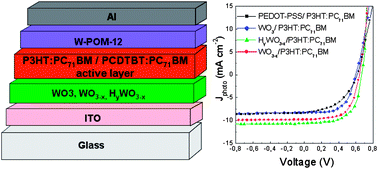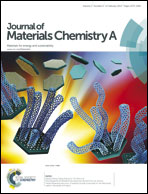Hydrogenated under-stoichiometric tungsten oxide anode interlayers for efficient and stable organic photovoltaics†
Abstract
In this work a hydrogenated under-stoichiometric tungsten oxide is introduced as an efficient anode interlayer in organic photovoltaics (OPVs). The benefits of hydrogen incorporation into the oxide lattice for obtaining desirable properties of tungsten oxides are explored. These benefits include the occupation of gap states near the Fermi level, which may facilitate charge transport, and the maintenance of a high work function, nearly similar to that of the stoichiometric tungsten oxide, which contributes to the formation of a large interfacial dipole at the anode interface and enhances charge extraction. A large improvement was achieved in the operational characteristics – especially in the open-circuit voltage – of bulk heterojunction solar cells based on different polymeric donors, namely poly(3-hexylthiophene), P3HT, or poly[(9-(1-octylnonyl)-9H-carbazole-2,7-diyl)-2,5-thiophenediyl-2,1,3-benzothiadiazole-4,7-diyl-2,5-thiophenediyl], PCDTBT, and the fullerene acceptor [6,6]-phenyl-C71 butyric acid methyl ester, PC71BM, that incorporated a hydrogenated tungsten oxide as an anode interlayer. This improvement was correlated with the devices' incident photon-to-electron conversion efficiencies (IPCEs) and impedance measurements. Furthermore, an increase in both the device's flat-band voltage (Vfb) and the doping level of the organic semiconductor was measured in P3HT:PC71BM based devices by Mott–Schottky capacitance analysis. Additional benefits are the large process window established for the devices incorporating the hydrogenated tungsten oxide as an anode interlayer and the maintenance of a high PCE (>80% of its initial efficiency) over 50 days, demonstrating good long-term stability, which is much better than that of the conventional devices based on PEDOT:PSS. The results suggest that the interface engineering with hydrogen-treated metal oxide interlayers is an important strategy to develop highly performing and stable organic photovoltaics.


 Please wait while we load your content...
Please wait while we load your content...